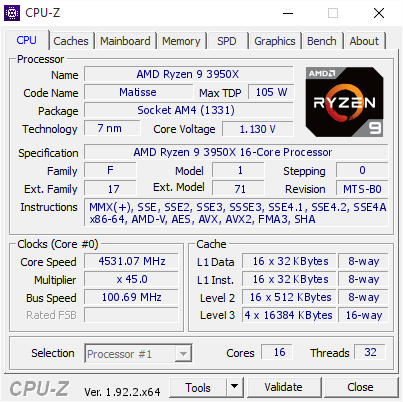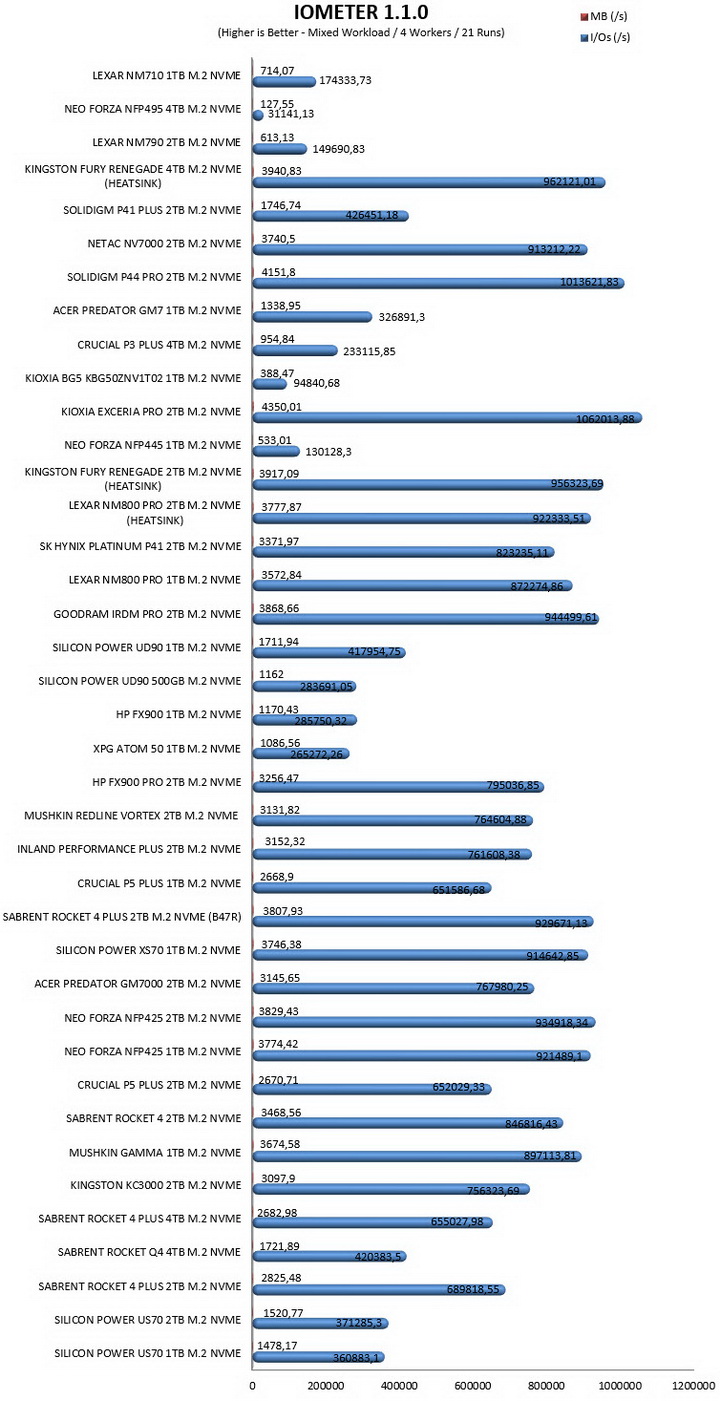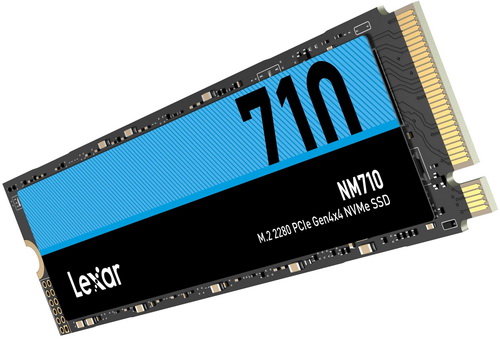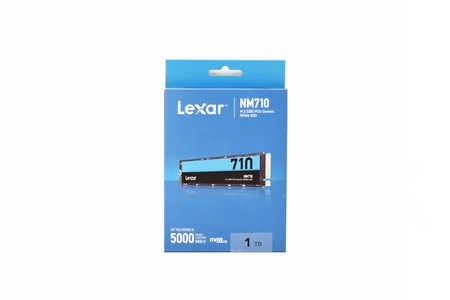INTRODUCTION

It's become abundantly clear as of late that most SSD manufacturers are not really invested in the release of PCIe 5.0 Gen5 models (primarily due to high temperature issues) and are instead focused in releasing low-cost PCIe 4.0 models based on new DRAM-less NAND flash controllers. Yes, such solutions may not be nowhere near as fast as some Gen4 SSD models based on higher performance NAND controllers complete with DRAM but still they should be plenty for most casual uses. A couple of weeks ago i tested the NM790 2TB Gen4 SSD by Lexar which was based on the DRAM-less MAP1602 12nm quad-channel controller by MaXio and since it did quite well today i decided to test its lower-end brother, the NM710 1TB.
For more than 25 years, Lexar has been a trusted leading global brand of memory solutions. Our award-winning lineup includes memory cards, USB flash drives, card readers, solid-state drives and DRAM. With so many options, it’s easy to find the right Lexar solution to fit your needs. All Lexar product designs undergo extensive testing in the Lexar Quality Labs with more than 1,100 digital devices, to ensure performance, quality, compatibility, and reliability. Lexar products are available worldwide at major retail and e-tail stores. For more information or support, visit www.lexar.com.
Just like the NM790 the NM710 line of PCIe 4.0 Gen4 M.2 NVMe SSDs (currently available in 500GB/1/2TB capacities) is also based on MaXio's DRAM-less MAP1602 12nm quad-channel (R5) NAND flash controller but unlike the former which came wearing 232-layer 3D TLC NAND flash by YMTC (X3 variant - Longsys branded) the latter wears 128-layer 3D TLC NAND flash (again by YMTC - Longsys branded). Once again, the MAP1602 12nm quad-channel NAND controller by MaXio packs quite a few features including advanced wear leveling algorithms, Host Memory Buffer (HMB) architecture (uses a fraction of your PC's system memory to cache mapping tables), pseudo SLC cache, bad block management strategy, hardware error-correction, L1.2 ultra-low power state and sudden power-loss protection, TRIM, NCQ, hardware support for AES256/SM4 encryption and support for TCG OPAL2.0. Typically, Lexar covers the entire NM710 line of Gen4 SSDs with a 5-year limited warranty and reports a MTBF of 1.5 million hours for all variants and a TBW (terabytes written) of 300 for the 500GB model, 600TB for the 1TB model and 1200 for the 2TB model.
SPECIFICATIONS AND FEATURES

PACKAGING AND CONTENTS
Typically, the front of the box has a product picture, advertised performance, capacity and the company logo.
The main product features are listed at the rear along with warranty information and contact details for Lexar.
A quick installation guide and a mounting screw are the two things placed in the box alongside the NM710 SSD.
THE NM710 1TB
The NM710 1TB has a sticker on top which includes the company and model names.


 Removing the sticker reveals the MaXio MAP1602 NAND flash controller and four 128-layer 3D TLC NAND flash modules.
Removing the sticker reveals the MaXio MAP1602 NAND flash controller and four 128-layer 3D TLC NAND flash modules.
Turning the SSD around we find yet another sticker which includes the serial and part numbers, barcode, country of manufacture and several certifications and warnings.
TEST BED


TESTING METHODOLOGY
Not long after I first started testing SSDs back in 2008, I concluded that it's almost impossible for any single benchmark suite to accurately measure their performance and that's why in certain benchmark suites we see amazing read/write performance numbers with some drives while in others things are quite different. The reason behind this is that some benchmarking suites are configured to read and write random chunks of data while others read and write constant (sequential) ones. So that's why i always use a very wide selection of benchmarking suites including AIDA64, HD Tach RW, HD Tune Pro, Crystal Disk Mark, Sisoftware Sandra Pro, AS SSD, IOmeter and ATTO. To get the most accurate results each test gets repeated a total of 6 times with the average performance numbers recorded into the charts*/****. Also, as of February 25th 2015 our results will also include the Storage Networking Industry Association’s (SNIA) IOMeter tests. These tests include a 12 Hour write test used to “simulate” performance degradation over time and a mixed workload test which basically shows what you can expect when using an SSD continuously for roughly two hours. Unfortunately, due to the time required for these tests they get repeated a total of 3 times and not 6 as the above.
Many people have made inquiries about our charts in the past so once again please do keep in mind that the Charts have the average performance numbers of each drive recorded and not the peak (highest) ones. Also, although every single one of these programs can help potential buyers choose the right drive for their needs you should also remember that from any kind of benchmark up to real world usage the gap is not small (and usually most differences will go unnoticed by most people). All tests were performed in a fresh Windows 10 Pro x64 installation complete with every update up to the date of this review.
* Since November 2018 the SSD comparison charts have been divided to 2.5” and M.2 models to reduce their growing size.
** Unless stated otherwise the Ryzen 9 3950x based Test Rig used for M.2 Gen 4 SSD reviews is not located in the lab.
*** As of January 2021 for Gen 3x4 models I’ll be using the Core i9-7980XE test rig (after numerous tests the up to 6% difference in read & write performance compared to the i7-6700 system simply wasn’t enough to justify having an extra test rig around).
**** Since February 2022 M.2 NVMe Gen3 and Gen4 SSD drives are placed in different charts.
TEST RESULTS - AIDA64 / ATTO


TEST RESULTS - HD TACH RW / HD TUNE PRO


TEST RESULTS - SISOFTWARE SANDRA PRO / CRYSTAL DISK MARK


TEST RESULTS - AS SSD / IOMETER


TEST RESULTS - IOMETER SNIA

CONCLUSION

MaXio seems to be taking over the affordable Gen4 SSD market with their MAP1602 NAND controller and for people looking for just that it’s a good thing. For good or bad however not everyone is looking to get their hands on an affordable drive, some people are actually waiting for more Gen5 SSDs to make their appearance and obviously that’s not happening. It’s not just Gen5 SSDs however, even the top-end Gen4 market has stood all but still for the last year or so and that too is not good. The same can be said for capacities since manufacturers seem to think that 4TB is more than plenty and well, it’s not. Yes, mostly enthusiasts and professionals will set their sights on 8TB models and so manufacturers may not see the benefit in releasing them but again this is something that needs to happen. All these aside however the NM710 by Lexar is still a valid upgrade for people looking to get something faster than a SATA III or even an Gen3 SSD (alas not by a large margin for the latter). Both performance and endurance numbers are good (always for the price) and the 5-year limited warranty obviously goes a long way.
With a current price tag set at just USD47.99 inside the USA (Amazon.com) and for 56.13Euros inside the EU (Amazon.de) the NM710 1TB Gen4 SSD by Lexar is priced extremely well. At the end of the day just like with most things what it all comes down to is just what your needs are and just how much you’re willing to spend and so if you happen to be a casual user looking for an affordable Gen4 SSD I strongly recommend giving the Lexar NM710 a chance.
PROS
- Overall Performance (For a DRAM Less Drive)
- 5 Year Limited Warranty
- Price (For Some)
CONS
- Thermal Throttling (During SNIA Tests)
- Only Up To 2TB

 O-Sense
O-Sense
















